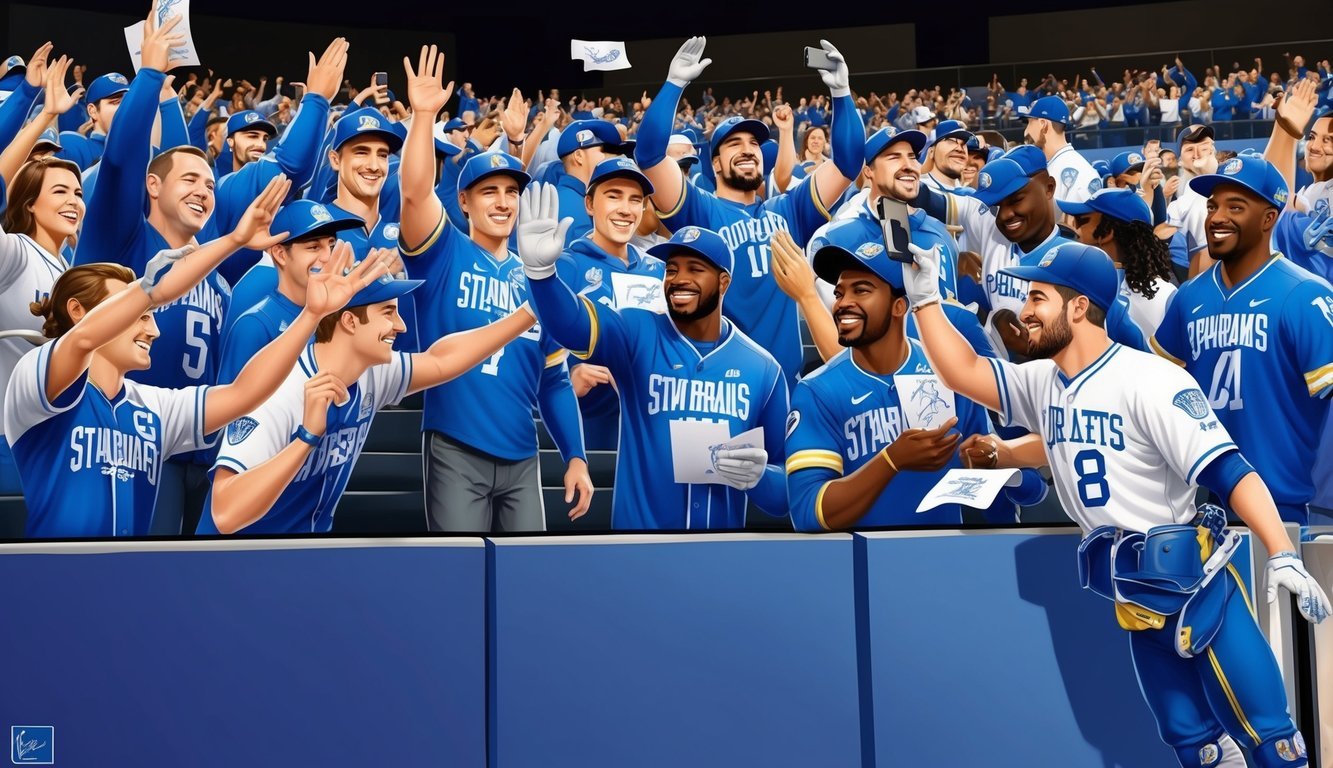Baseball general managers play a crucial role in shaping the destiny of their teams.
These behind-the-scenes masterminds orchestrate player trades, negotiate contracts, and build rosters capable of competing for the World Series. For fans who dream of stepping into a GM’s shoes, several engaging baseball simulation games offer the chance to test their strategic skills.
ZenGM Baseball and BaseHit provide immersive experiences where players can draft talent, make trades, and guide their virtual franchises to glory.
These games allow baseball enthusiasts to dive deep into the intricacies of team management, from developing prospects in the minor leagues to assembling a championship-caliber roster at the highest level.
The allure of becoming a baseball GM extends beyond just building a winning team.
Creating a dynasty that dominates the sport for years requires careful planning, shrewd decision-making, and a bit of luck.
Whether it’s through free online platforms like Broken Bat or mobile apps like Ultimate Baseball GM 2024, aspiring general managers can hone their skills and pursue their dreams of baseball greatness from the comfort of their own devices.
Roles and Responsibilities of a Baseball GM
Baseball general managers shape their team’s destiny through strategic decisions and leadership.
They balance multiple priorities to build a competitive roster while managing financial constraints.
Building a Competitive Team
GMs assess player talent and construct rosters to maximize on-field success.
They work closely with scouts, coaches, and analytics teams to evaluate players.
GMs set the team’s overall strategy and playing style.
They identify areas of need and target players who fit the team’s vision.
Developing young talent is crucial.
GMs oversee the farm system and make decisions on promoting prospects to the major leagues.
They also manage relationships with current players, addressing concerns and negotiating contract extensions when appropriate.
Managing Finances
GMs must operate within budgetary limits set by team ownership.
They allocate resources across player salaries, scouting, player development, and other areas.
They analyze potential return on investment for player contracts.
GMs aim to maximize value while avoiding overpaying for talent.
Revenue considerations factor into decisions.
GMs may target marketable players to boost ticket sales and merchandise revenue.
Balancing short-term competitiveness with long-term financial flexibility is an ongoing challenge.
GMs must avoid crippling contracts that hamper future moves.
Navigating the Draft
The amateur draft is a critical talent pipeline.
GMs work with scouting directors to rank prospects and develop draft strategies.
They must weigh factors like a player’s potential, signability, and fit within the organization.
High draft picks can shape a franchise for years to come.
GMs often personally scout top prospects.
They may also negotiate signing bonuses with draftees and their agents.
The international amateur market is another key area.
GMs oversee scouting and signing of young talents from Latin America and Asia.
Trading and Free Agents
GMs are dealmakers, constantly exploring trade possibilities with other teams.
They assess their own roster needs and identify potential trade partners.
During trade talks, GMs negotiate player packages, cash considerations, and other deal terms.
Major trades can dramatically reshape a team overnight.
In free agency, GMs pursue top talents on the open market.
They craft contract offers, pitch players on joining the organization, and close deals.
GMs must also decide when to trade away veterans for prospects or let players leave in free agency.
These choices impact both short and long-term competitiveness.
Crafting a Winning Strategy
Building a successful baseball team requires a multifaceted approach.
General managers must balance player development, pitching depth, and data-driven decision-making to create a competitive roster year after year.
Developing a Strong Farm System
A robust farm system is the lifeblood of any baseball dynasty.
GMs should invest heavily in scouting and player development.
International signings and draft picks form the foundation of future success.
Top prospects can be nurtured through the minor league system, honing their skills before reaching the majors.
This strategy provides a steady stream of young, cost-controlled talent.
Trading surplus prospects for established players can fill roster gaps.
A well-stocked farm system gives GMs flexibility in roster construction and trade negotiations.
Building a Sustainable Pitching Staff
Pitching wins championships.
GMs must prioritize assembling a deep, versatile pitching staff.
A strong rotation anchors the team, while a reliable bullpen secures close games.
Balancing veteran arms with developing prospects ensures long-term stability.
Injury prevention and load management are crucial for maintaining pitcher health throughout the season.
GMs should target pitchers with diverse arsenals and strong command.
Ground ball specialists can thrive in hitter-friendly parks, while strikeout artists excel in spacious stadiums.
Valuing Stats and Analytics
Modern GMs rely heavily on advanced statistics and analytics to gain a competitive edge.
Sabermetrics help identify undervalued players and optimize lineup construction.
Key metrics like WAR, wOBA, and FIP provide deeper insights than traditional stats.
Data-driven approaches to defensive positioning and pitch sequencing can dramatically improve team performance.
Analytics also inform player development strategies.
Tracking spin rates, launch angles, and exit velocities helps coaches refine players’ skills.
GMs must blend statistical analysis with scouting reports to make informed roster decisions.
Achieving and Sustaining Success

Building a winning baseball franchise requires vision, skill, and perseverance.
Successful general managers focus on creating dynasties, securing championships, and fostering a strong team culture.
Establishing a Baseball Dynasty
A baseball dynasty starts with smart drafting and player development.
GMs scout young talent and nurture prospects through a robust farm system.
They balance short-term needs with long-term goals, often making tough decisions to trade fan favorites for future stars.
Key moves include locking up core players to long-term contracts and supplementing homegrown talent with strategic free agent signings.
The New York Yankees’ late 1990s dynasty, for example, blended homegrown stars like Derek Jeter with key acquisitions like Paul O’Neill.
Successful GMs also invest in cutting-edge analytics and technology to gain competitive advantages in player evaluation and on-field strategies.
Securing Championships and Playoff Appearances
Reaching the playoffs consistently is a hallmark of great baseball operations.
GMs build rosters that can withstand the grind of a 162-game season and peak at the right time for October baseball.
This involves:
- Constructing a deep pitching staff
- Balancing power hitters with on-base specialists
- Acquiring versatile bench players
- Building a shutdown bullpen
GMs must also be adaptable, making midseason trades to address weaknesses or capitalize on unexpected opportunities.
The ability to recognize and acquire undervalued players often separates good teams from great ones.
Maintaining a Strong Team Culture
A winning culture starts at the top.
GMs work closely with owners and coaches to create an environment where players can thrive.
This includes:
- Hiring the right manager and coaching staff
- Setting clear expectations for player conduct
- Fostering a sense of team unity and shared purpose
- Balancing veteran leadership with youthful energy
Successful GMs also prioritize player development at all levels of the organization.
They create pathways for young talent to reach the majors and contribute to the team’s success.
Building relationships with players, agents, and other executives is crucial.
A positive team reputation can attract free agents and facilitate trades, giving the GM more tools to sustain success over time.
Comparative Perspectives

General managers in baseball face unique challenges compared to other sports.
Their roles extend beyond team building to global talent scouting and long-term strategic planning.
Differences Between Baseball and Basketball GM
Baseball GMs manage larger rosters and farm systems than their basketball counterparts.
They oversee up to 40 players on the major league roster and hundreds in the minor leagues.
Basketball GMs typically handle 15-player rosters.
Baseball GMs focus more on player development, often drafting high school prospects who may take years to reach the majors.
Basketball GMs usually draft players ready for immediate impact.
The longer baseball season (162 games vs 82 in basketball) requires GMs to build deeper rosters and manage player fatigue.
Baseball trades are more frequent, with GMs constantly adjusting their teams throughout the season.
Global Influence on Baseball Management
Baseball’s international appeal has transformed GM roles.
They now coordinate extensive scouting networks across Latin America, Asia, and Europe.
Many GMs employ multilingual staff to communicate with foreign players and navigate international signing rules.
Some even establish baseball academies in countries like the Dominican Republic.
The World Baseball Classic has increased global competition for talent.
GMs must now consider how international tournaments affect player availability and development.
Japanese baseball’s success has led some MLB teams to adopt their training methods.
Forward-thinking GMs study global best practices to gain competitive edges in player development and team-building strategies.
Engaging with Fans and the Community

Baseball general managers play a crucial role in fostering connections between the team and its supporters.
They implement strategies to enhance fan experiences and strengthen community ties.
The Role of Media and Public Relations
GMs work closely with media and PR teams to shape the team’s public image.
They facilitate player interviews, press conferences, and social media interactions.
This helps humanize players and build emotional connections with fans.
GMs also oversee community outreach programs.
These may include charity events, youth clinics, and school visits.
Such initiatives create goodwill and expand the team’s fanbase.
The Toronto Blue Jays, for example, use their social platforms to share behind-the-scenes content.
This gives fans an inside look at the team’s daily operations and player personalities.
Enhancing the Fan Experience
GMs focus on creating memorable experiences at the ballpark.
They may introduce new in-game entertainment, upgrade stadium facilities, or implement fan-friendly technologies.
Many teams now offer free Wi-Fi and mobile apps.
These tools provide stats, replays, and ordering services to enhance game day enjoyment.
Some clubs have introduced “theme nights” or special promotions.
These events cater to different fan interests and attract diverse audiences.
GMs also consider fan feedback when making decisions.
They might conduct surveys or host town hall meetings to gather input on team operations and fan preferences.
